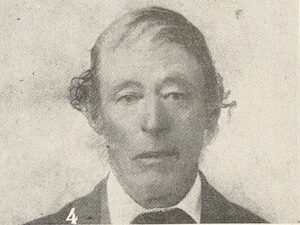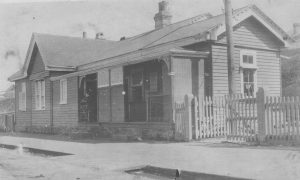The roadrunner: William Byrne, mining fields mailman. Part One: The Mount Bischoff mail.
William Byrne (c1828–1911) was tall, muscular, clean shaven and long-haired, and he spun a yarn like Fenimore Cooper.[1] If he lacked the zip of the Warner Brothers bird and the insight of that other roadrunner, Forrest Gump, he made up for it in persistence. It was said that had all his West Coast mail trips been strung together end to end—on a floating bridge, presumably—he could have rounded England and returned.
Byrne’s reputed ex-soldier father John Byrne might have preferred an Irish homecoming.[2] In 1842 the Byrne family, including teenaged William and four siblings, were ensconced in a timber house at Horse Shoe Farm, Coal River, in the southern Midlands, but the lure of a fertile Van Diemen’s Land Company tenancy was apparently enough to pack them off to Cooee Creek in the north-west.[3] Success on the Victorian goldfields won William his own property at Mooreville Road, where he was said to have been one of the pioneers of the potato trade to Sydney.[4] In chartering a schooner for direct trade with Sydney, Byrne displayed the sort of initiative that would win him long-distance mail contracts. Labouring on the farm must have given him his endurance.
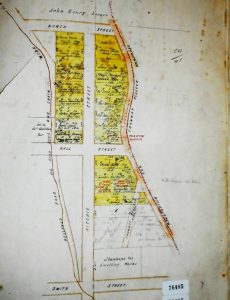
This 1876 Charles Sprent survey of Waratah lots shows the original dray route (left) to Mount Bischoff
known as Bog Lane. Survey 76458, courtesy of DPIPWE.
The Mount Bischoff mail
The first ‘road’ to Waratah took a wide sweep from Browns Marsh on the Surrey Hills block across Knole Plain, before approaching the town from the south-west through a muddy tunnel in the horizontal scrub known at Bog Lane. This was the track rutted out by ore carters employed by the Mount Bischoff tin mines. Early mail delivery depended on the good will of travellers between Emu Bay and the Mount. The government demanded a quid pro quo before investing in Bischoff. Chairman of directors of the Mount Bischoff Co William Ritchie reported in December 1873 that
‘the Government now virtually repudiate their promise of a pound a week towards the expense of a weekly mail. They also decline to give anything towards the road—but say that when twenty leases shall have been granted and the rent paid they will take our application into consideration’.[5]
The Mount Bischoff Co took the matter into their own hands, contracting William Byrne as its mailman at £90 per year.[6] Presumably he rode a horse where possible, leading it the rest of the way. Mine manager WM Crosby became the first Mount Bischoff postmaster, pocketing £60 per year on top of his manager’s salary.[7] Byrne did things his way, his method of carrying loose letters horrifying the Emu Bay postmistress.[8] (However, as it turned out, that was nothing compared to his treatment of newspapers.) Byrne was contracted to arrive at Waratah each Tuesday at 2pm, seven hours before the outgoing mail closed. However, he usually appeared at dusk, putting locals into a flurry answering their mail in the short time remaining.[9]
As the volume of mail increased, the Mount Bischoff Co petitioned the government, which finally agreed to take over responsibility for the entire mail service at the expiration of Byrne’s contract.[10] In the meantime, Byrne was accused of delivering mail to the wrong people because he was illiterate—but he wasn’t illiterate, and other Byrne clients vouched for his services.[11] When, inevitably, he lost his mail contract to the VDL Co’s tramway service, his clients farewelled him with a signed testimonial expressing their gratitude.[12]
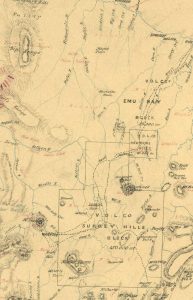
A crop from Charles Sprent’s 1879 chart shows the original dray ‘road’ to Mount
Bischoff via Knole Plain, the line of the VDL Co’s horse-drawn tramway and the
later line of road into Waratah, deviating from the other near the Hellyer River.
From AF395/1/41 (TAHO).
Carrying the mail on the Emu Bay and Mount Bischoff Tramway
The VDL Co’s horse-drawn tramway was completed to its original terminus of Rouses Camp, 4 km from Waratah, in 1878. The company began to provide a tri-weekly service, contracted to arrive in Waratah at 5pm. You might expect a commercial transport operator to trounce a lone horseman for efficiency, but VDL Co manager James Norton Smith knew that rogue elements governed his service.
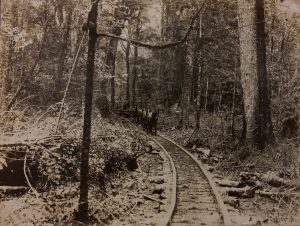
A VDL Co tram operating in the forest at the 29-Mile mark. It demonstrates the basic technology of a horse-drawn, timber-railed tramway. Courtesy of the Burnie Regional Museum.
Firstly, if the mail was late reaching Burnie, it was late starting for Bischoff. Then there were the employees. Through the building of the tramway, and now in its operation, the temperance wagon was frequently overturned. Daniel Shine, timekeeper at Rouses Camp, was a valuable informant on local affairs, but also a regular drunkard.[13] On two occasions Norton Smith sacked him, only to reinstate the repentant man.[14] Driver Higgs posed such a threat to the public that he was relegated to support duties.[15] Hampshire Hills stableman and storekeeper ‘Dusty’ Miller got ‘on the spree’.[16] Even tramway inspector Hugh Lynch was known to get ‘on the burst’.[17] Henry Crispin was ‘hopelessly drunk and asleep behind a log’ near Michael Bevan’s Hampshire Hotel in March 1877 when an accident happened on the line that he could have averted.[18] With so many imbibers along the way it probably wasn’t a surprise when a case of whisky consigned to Bevan disappeared in transit in 1878.[19] The publican later went to fisticuffs with tram driver William Lennard.[20]
Thirdly, there were the horses. The tramway was an equine graveyard. Many injured animals must have been shot. In 1879 Shine gave a requiem for four of the six animals meant to be in harness, telling Norton Smith:
‘”‘Black Wallace” was bled to death yesterday. “White Prince” is given over [useless]. “Punch” is expected to go the way of all flesh tomorrow, and “Wallace” … is crippled and not expected to do any more work, so that I expect it will be some time before we shall have full loading on our trucks’.[21]
Norton Smith’s accountant RA Murray recalled a horse named Boxer returning to Emu Bay
‘with his shoulders literally cut to pieces. They actually look as if a dog or some animal had eaten a piece out of them, and he is either strained in the forequarters or something internally wrong, as it is with the greatest difficulty he can walk at all’.[22]
Those with treatable conditions required careful attention. In 1882 an employee at Hampshire sent a long list of medicines required to fix the horses under his charge—including licorice powder, antimonial powder, camphor powder and tartarized antimony.[23]
Equine unpredictability also led to thrills and spills. In December 1879 the grey horse Turpin shied at the 39-mile mark, throwing Launceston brewer John Glennwright under the mail truck.[24] The passenger spat blood, sustaining injuries that his solicitor valued at £500.[25] There were other accidents with a human cause. On another occasion the brake broke near Rouse’s gate, fracturing one horse’s ribs, killing two sheep and breaking the legs of three others.[26] In January 1882 the mail coach was derailed in a collision with a trolley left on the track near Waratah, throwing passengers out of their carriage.[27]
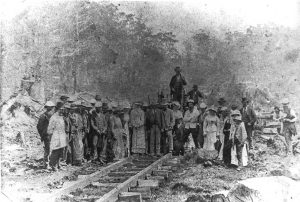
Opening of the Emu Bay and Mount Bischoff Tramway at Rouses Camp, 1 February 1878. PH30/1/1865 (Libraries Tasmania).
Dick Leach drives the ‘rabbit hutch with wheels’
These were the variables governing delivery of the ‘Royal Mail’. However, the well-known tram driver Dick Leach (1844?–85) certainly delivered through hail, rain and snow. Born into a Bog Irish family, he grew up alongside the Gaffneys at Arms of the Creek, part of the ‘Paddys Scrub’ Irish enclave near Deloraine, his younger brother James Leach being the well-known drover and West Coast meat supplier.[28]
Leach generally wasn’t responsible for the very uncomfortable customer experience of riding the Emu Bay and Mount Bischoff Tram. One customer suggested that the passenger carriage of the ‘rabbit hutch with wheels’ might be better suited as a public toilet, while another preferred to walk back to Emu Bay than suffer a second dose of the ‘wretched vehicle … a cross between a small cattle truck and a sardine tin …’[29] It does seem to have been true, though, that Dick liked a tipple, once being given notice to apologise ‘and keep order’ after boozily abusing a customer.[30] Fortunately for him, there was no breathalyser on the tramway.
Like Byrne, Leach was branded with illiteracy. It was alleged that he carried letters up and down the line for days without delivering them ‘because he couldn’t read himself and he was too independent to ask anyone else to look at them’. If anyone complained about this behavior, the complainant stated,
‘he would grumble and say he need not carry any letters along the line at all, he only done it to oblige people, he only had to carry them from one post office to the other …’[31]
In this case it was probably true: Leach couldn’t sign his own name on his marriage certificate.[32]

Waratah in 1881, showing the Mount Bischoff Co’s bridge over the Waratah River and the Stanhope Smelter on the hill at left.
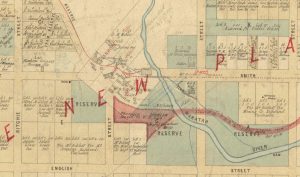
Waratah c1880, showing the Mount Bischoff Co’s tramway bridge as the only crossing of the Waratah River. The deviation of Smith Street around the Mount Bischoff Co’s machinery site is sketched in, as is the VDL Co’s proposed station and railway formation. The reserve for the post office is represented by the blank block on Smith Street, conveniently located next to the Stanhope Smelter.
Cropped from AF721/1/755 (TAHO).
In November 1881 the tramway was finally extended—with iron rails—into Waratah.[33] Since the attendant VDL Co mail service gave Bischoffites a turnaround of only two hours, they conducted much of their postal and telegraphic business by candle or lamplight in the early evening—and not in a purpose-built post office, but at the house of Charles Hall, 2IC at the Mount Bischoff Mine. At first there was no public bridge across the Waratah River. Many customers had to negotiate the narrow Mount Bischoff Company tramway bridge in the dark to reach Hall’s house in Smith Street, opposite St James’ Church.[34] The ad hoc post office was transferred to Stutterd’s house in June 1881, but evening business continued to be troublesome, customers having to provide their own lighting in order to send and collect mail or telegrams.[35] Miss Dixon was postmistress and mudlark, fulfilling the unenviable task of delivering telegrams in all weathers and all depths of mud.[36]
The government built Waratah a post and telegraph office just as the VDL Co was unveiling its steam railway. The redundant Dick Leach moved to another mail service. He was killed when his horses shied while he was driving the coastal mail coach out of Forth in 1885, aged only 41.[37] It was reported that most of the coach passengers had abandoned the service because they believed Leach was drunk.[38] No mail reached Waratah that day as a result of his accident.[39]
[1] ‘Shaughraun’, ‘Notes off and on’, Tasmanian, 17 May 1884, p.28. American novelist James Fenimore Cooper (1789–1851) wrote romantic tales of frontier life such as The last of the Mohicans (1826) and The prairie (1827).
[2] See Richard Hilder, ‘Pioneers of Emu Bay: John Byrne of Uplands’, Advocate, 10 March 1926, p.11; Richard Hilder, ‘The real pioneers of Emu Bay and the town of Burnie’, Advocate, 10 April 1935, p.10. The story of John Byrne coming to Van Diemen’s Land as a soldier sounds rather like a convict smokescreen, except that the 1842 census record contains the claim that John Byrne and his wife arrived in the colony free. There are no Tasmanian birth records for William Byrne and his brother John, who could well have been born in New South Wales or even Ireland. Yet William Byrne claimed to have been born in Hobart.
[3] See Census of Van Diemen’s Land, 1842, CEN1/1/39–113 (TAHO), https://librariestas.ent.sirsidynix.net.au/client/en_AU/names/search/detailnonmodal/ent:$002f$002fNAME_INDEXES$002f0$002fNAME_INDEXES:473341/one?qu=john&qu=byrne&qf=NI_INDEX%09Record+type%09Census%09Census, accessed 2 October 2020. ‘Foreshore rights’, Daily Telegraph, 5 November 1901, p.4. John Byrne died at Emu Bay on 25 May 1854, aged 56, death record no.57/1854, registered at Horton (Stanley), RGD35/1/23 (TAHO), https://librariestas.ent.sirsidynix.net.au/client/en_AU/names/search/results?qu=john&qu=byrne&qf=NI_INDEX%09Record+type%09Deaths%09Deaths#, accessed 28 September 2020. He left a wife, Margaret Harris, and eight children. Margaret Byrne, née Harris, died at Emu Bay in 1885, aged 85 (‘Deaths’, Launceston Examiner, 30 September 1885, p.1).
[4] ‘Passing of a pioneer’, North Western Advocate and the Emu Bay Times, 7 June 1911, p.2; Richard Hilder, ‘The real pioneers of Emu Bay’, Advocate, 9 February 1935, p.9. Twenty-five-year-old William Byrne married 20-year-old Ann McKee on 1 February 1855 by Roman Catholic rites, marriage record no.1106/1855, registered at Oatlands, RGD37/1/14 (TAHO), https://librariestas.ent.sirsidynix.net.au/client/en_AU/names/search/results?qu=william&qu=byrne, accessed 23 September 2020. Both were ‘free’ and signed their own names. Their son John Byrne was born on 1 July 1858, birth record no.400/1858, registered at Emu Bay, RGD33/1/36 (TAHO), https://librariestas.ent.sirsidynix.net.au/client/en_AU/names/search/results?qu=NI_NAME%3D%22Mckee,%20Ann%22, accessed 23 September 2020.
Their son Alfred Byrne was born on 1 July 1858, birth record no.400/1858, registered at Emu Bay, RGD33/1/36 (TAHO), https://librariestas.ent.sirsidynix.net.au/client/en_AU/names/search/results?qu=NI_NAME%3D%22Mckee,%20Ann%22, accessed 23 September 2020. The father was a farmer at New Country, Emu Bay.
[5] William Ritchie to James Smith, 17 December 1873, NS234/3/1/2 (TAHO).
[6] Minutes of the Mount Bischoff Tin Mining Co directors’ meetings for 1875 and 1876 reveal that he received £7 10 shillings per month, or £90 per year. William Byrne’s brother John Byrne (‘senior’) and son John Byrne (‘junior’) were also on the Mount Bischoff Co payroll as ore carters in the years before the Emu Bay and Mount Bischoff Tramway was completed. See NS911/1/1 (TAHO).
[7] Minutes of Mount Bischoff Tin Mining Co directors’ meetings, 21 June 1875, NS911/1/1 (TAHO). Crosby was paid by the government; Byrne, the mailman, was paid by the Mount Bischoff Co.
[8] ‘Mount Bischoff’, Cornwall Chronicle, 19 September 1874, p.3; Minutes of Mount Bischoff Co, 6 September 1875, NS911/1/1 (TAHO).
[9] ‘Mount Bischoff’, Launceston Examiner, 20 June 1876, p.3.
[10] Minutes of Mount Bischoff Tin Mining Co directors’ meetings, 7 June 1875, 20 March and 20 April 1876, NS911/1/1 (TAHO).
[11] ‘Watchman’, ‘A grievance’, Tribune, 7 December 1878, p.2; John Lay, E Johnstone, W Nelms and E Dunstan to James Norton Smith, 16 December 1878, VDL22/1/6 (TAHO).
[12] ‘Bischoff’, Mercury, 14 May 1878, p.2; Advert, Cornwall Chronicle, 20 February 1879, p.13.
[13] See, for example, Daniel Shine on the Browns Plain rush in his letters to James Norton Smith, 15 and 20 January 1879, VDL22/1/7 (TAHO).
[14] James Norton Smith to RA Murray, 26 December 1877; Daniel Shine to James Norton Smith, 22 January 1878?, VDL22/1/5 (TAHO).
[15] Hugh Lynch to James Norton Smith, 23 April 1877; RA Murray to James Norton Smith, 26 December 1877, VDL22/1/5 (TAHO).
[16] RA Murray to James Norton Smith, 14 May 1879, VDL22/1/5 (TAHO).
[17] RA Murray to James Norton Smith, 14 May 1879.
[18] RA Murray to James Norton Smith, 20 March 1877, VDL22/1/5 (TAHO).
[19] Michael Bevan to James Norton Smith, 18 February 1878, VDL22/1/4 (TAHO).
[20] Michael Bevan to James Norton Smith, 17 February and 23 June 1880, VDL22/1/8 (TAHO).
[21] Daniel Shine to James Norton Smith, 1 October 1879, VDL22/1/7 (TAHO).
[22] RA Murray to James Norton Smith, 8 May 1877, VDL22/1/5 (TAHO).
[23] Robert Harris to James Norton Smith, 12 September 1882, VDL22/1/10 (TAHO).
[24] RA Murray to James Norton Smith, 11 December 1879, VDL22/1/7 (TAHO).
[25] Josiah Powell to James Norton Smith, 25 June 1880, VDL22/1/8 (TAHO).
[26] RA Murray to JC Climie, 16 October 1877, VDL22/1/5 (TAHO).
[27] ‘Observer’, ‘The late accident at Waratah’, Launceston Examiner, 6 January 1882, p.3; ‘Fortnightly summary of news for home readers’, Mercury, 2 January 1882, p.1.
[28] See 1848 census record for John Leach and family, CEN1/1/104 (TAHO), https://librariestas.ent.sirsidynix.net.au/client/en_AU/names/search/results?qu=NI_NAME%3D%22Leach,%20John%22, accessed 25 September 2020. Richard Leach appears to have been the cause of the marriage of 30-year-old John Leach and 21-year-old Anne Mullins, both ex-convicts, at Launceston in 1844. No birth certificate has been found for him, but he was said to be 41-year-old at his death.
For James Leach see Nic Haygarth, ‘Frontiersmen five: the Gaffney brothers, building, supplying and hosting Tasmania’s west coast mining fields’, Journal of Australasian Mining History, vol.17, October 2019, pp.59–71.
[29] ‘A Late Victim’, ‘Railway to Mount Bischoff’, Launceston Examiner, 9 September 1879, p.3; ‘Sicnarf Gink’ (Francis King), ‘Mount Bischoff Tramway’, Launceston Examiner, 11 September 1879, p.3.
[30] TD Patterson to RA Murray, 14 July 1882; James Norton Smith note on letter dated 15 July 1882, VDL22/1/10 (TAHO).
[31] John Deacon to James Norton Smith, 26 October 1882, VDL22/1/10 (TAHO).
[32] Twenty-seven-year-old Richard Leach married 32-year-old Elizabeth Lawson by Australasian Wesleyan rites on 25 December 1871 at the house of George Lawson, Chudleigh, marriage record no.79/1871, registered at Deloraine, RGD37/1/30 (TAHO), https://librariestas.ent.sirsidynix.net.au/client/en_AU/names/search/results?qu=richard&qu=leach, accessed 26 September 2020.
[33] ‘Waratah’, Mercury, 23 November 1881, p.1.
[34] ‘Bischoff’, Tasmanian Mail, 19 July 1879, 1879, p.15; ‘Mount Bischoff’, Tasmanian Mail, 9 October 1880, p.4.
[35] ‘Mount Bischoff’, Mercury, 23 July 1881, p.2; ‘The Owl’, ‘Records of a fortnight in Waratah’, Launceston Examiner, 30 August 1883, p.4.
[36] ‘Silverpen’ (Henry Glennie), ‘From Launceston to Waratah, Mount Bischoff’, Launceston Examiner, 17 September 1883, p.3.
[37] ‘Hamilton-on-Forth: fatal accident at the Forth’, Daily Telegraph, 8 June 1885, p.3.
[38] ‘Late coach accident’, Launceston Examiner, 9 June 1885, p.3.
[39] Accident to the NW mail coach’, Launceston Examiner, 8 June 1885, p.3.

